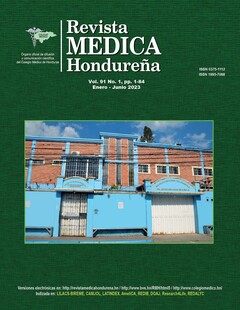Epidemiological characterization of patients with COVID-19 in the Sanitary Region of Francisco Morazán, Honduras
DOI:
https://doi.org/10.5377/rmh.v91i1.16286Keywords:
Coronavirus, Coronavirus Infections, COVID-19, SARS-CoV-2Abstract
Background: SARS-CoV-2 virus infection causes coronavirus disease 2019 (COVID-19). Objective: Epidemiologically characterize the patient with COVID-19, Departmental Health Region of Francisco Morazán (RSDFM), Honduras, March 2020-January 2021. Methods: Retrospective descriptive study. Included n=11,401 users who underwent diagnostic confirmation in the RSDFM. General and monthly incidence of COVID-19 was calculated as rates per 10,000 inhabitants, municipal incidence rates (positive cases/10,000). Case fatality rate (deceased/100 positive cases). Results: Of the total 3,680 users, the average age of the positive cases was 36.8 years old (SD+/-17.9; female sex 53.3% (1,962), Valle de Ángeles origin 20.4% (752). The epidemiological nexus was contact with a positive family member or friend. or died from COVID-19 in 96.3% (3544).The general incidence rate was 92.4/10,000.The municipality of Valle de Ángeles presented the highest incidence rate 366.1/10,000. The fatality rate was 1.8% (68 /3680) Discussion: The findings of this study are compatible with other authors regarding the epidemiological characteristics and symptoms, identifying a higher risk of mortality in individuals aged ≥60 years (35/418 vs <60 years 32/3194; p=0.000, OR: 8.60, IC95%: 5.15-14.37), as well as for the male sex (48/1670 vs 20/1942; p=0.000, OR:2.79, IC95%: 1.61-4.89). The months with the highest incidence of cases in the RSDFM were the months from June to July 2020 and December 2020 to January 2021. Studies of this type strengthen the epidemiological approach to epidemics/pandemics.
Downloads
327
Downloads
Published
How to Cite
Issue
Section
License
Copyright (c) 2023 Autor(es)

This work is licensed under a Creative Commons Attribution 4.0 International License.




